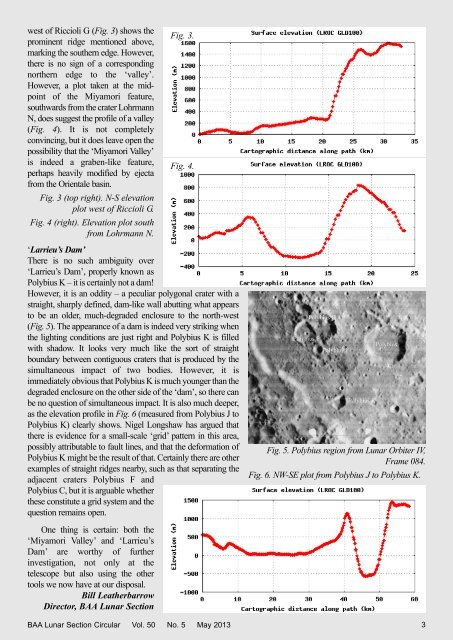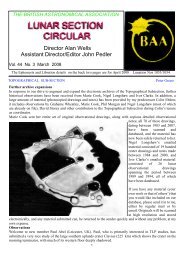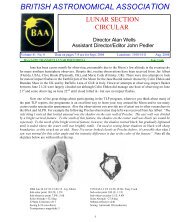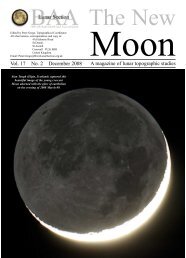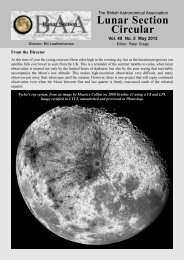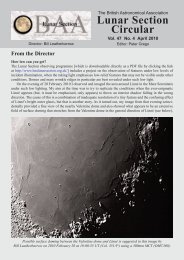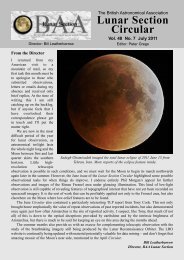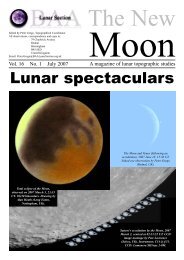Vol 50, No 5, May 2013 - BAA Lunar Section
Vol 50, No 5, May 2013 - BAA Lunar Section
Vol 50, No 5, May 2013 - BAA Lunar Section
- No tags were found...
You also want an ePaper? Increase the reach of your titles
YUMPU automatically turns print PDFs into web optimized ePapers that Google loves.
west of Riccioli G (Fig. 3) shows theprominent ridge mentioned above,marking the southern edge. However,there is no sign of a correspondingnorthern edge to the ‘valley’.However, a plot taken at the midpointof the Miyamori feature,southwards from the crater LohrmannN, does suggest the profile of a valley(Fig. 4). It is not completelyconvincing, but it does leave open thepossibility that the ‘Miyamori Valley’is indeed a graben-like feature,perhaps heavily modified by ejectafrom the Orientale basin.Fig. 3 (top right). N-S elevationplot west of Riccioli G.Fig. 4 (right). Elevation plot southfrom Lohrmann N.Fig. 3.Fig. 4.‘Larrieu’s Dam’There is no such ambiguity over‘Larrieu’s Dam’, properly known asPolybius K – it is certainly not a dam!However, it is an oddity – a peculiar polygonal crater with astraight, sharply defined, dam-like wall abutting what appearsto be an older, much-degraded enclosure to the north-west(Fig. 5). The appearance of a dam is indeed very striking whenthe lighting conditions are just right and Polybius K is filledwith shadow. It looks very much like the sort of straightboundary between contiguous craters that is produced by thesimultaneous impact of two bodies. However, it isimmediately obvious that Polybius K is much younger than thedegraded enclosure on the other side of the ‘dam’, so there canbe no question of simultaneous impact. It is also much deeper,as the elevation profile in Fig. 6 (measured from Polybius J toPolybius K) clearly shows. Nigel Longshaw has argued thatthere is evidence for a small-scale ‘grid’ pattern in this area,possibly attributable to fault lines, and that the deformation ofPolybius K might be the result of that. Certainly there are otherexamples of straight ridges nearby, such as that separating theadjacent craters Polybius F andPolybius C, but it is arguable whetherthese constitute a grid system and thequestion remains open.Fig. 5. Polybius region from <strong>Lunar</strong> Orbiter IV,Frame 084.Fig. 6. NW-SE plot from Polybius J to Polybius K.One thing is certain: both the‘Miyamori Valley’ and ‘Larrieu’sDam’ are worthy of furtherinvestigation, not only at thetelescope but also using the othertools we now have at our disposal.Bill LeatherbarrowDirector, <strong>BAA</strong> <strong>Lunar</strong> <strong>Section</strong><strong>BAA</strong> <strong>Lunar</strong> <strong>Section</strong> Circular <strong>Vol</strong>. <strong>50</strong> <strong>No</strong>. 5 <strong>May</strong> <strong>2013</strong> 3


